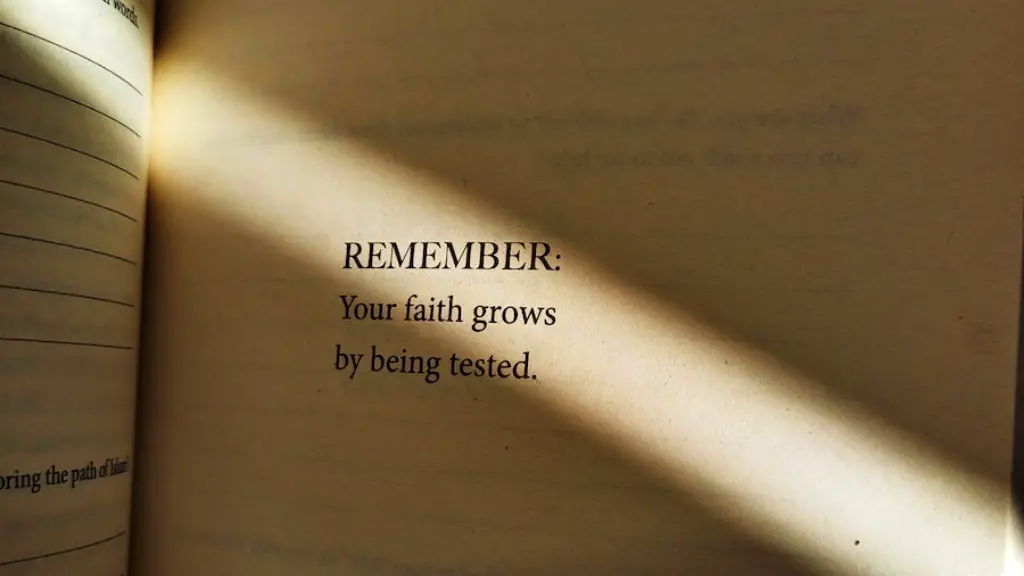Maya Angelou’s poetry is renowned as deeply emotive, powerful, and moving. She is celebrated for her exploration of the African-American experience and her contributions to both the world of literature and civil rights. One of the most famous poems written by Maya Angelou is her ‘Still I Rise’, published in 1978 and since become iconic. The poem is often interpreted as an anthem of hope, encouraging resilience and liberation.
On its surface ‘Still I Rise’ is deeply personal and speaks to the unique suffering of African-Americans under an oppressive and discriminatory system. The language is forceful and resolute, with the speaker of the poem refusing to be broken down, instead proclaiming her will to rise even in the face of hatred, bigotry and humiliation. It speaks to a core need of the human soul, to build and nurture connections even when faced with seemingly insurmountable odds.
The poem is composed of simple but powerful lines, each emphasizing the speaker’s refusal to stay down in the face of great adversity. Lines such as ‘just like moons and like suns, with the certainty of tides, just like hopes springing high, still I’ll rise’ speak to Angelou’s timeless and universal message of hope and resilience. Even when faced with oppressive systems and discrimination, the poem affirms that we are all capable of rising above these difficulties and creating a better future.
In spite of its simple structure and language, the poem is highly complex and its meaning often varies depending on the reader. The poem’s premise of resilience is applicable to any circumstance, and can provide solace to the reader in times of difficulty. Moreover, the poem’s simple and accessible language means that it can be enjoyed by people of all ages and cultural backgrounds, enhancing its universality.
Maya Angelou’s ‘Still I Rise’ is a powerful piece of poetry that speaks to the collective human experience. Its simple but emotive language allows it to resonate with any reader, regardless of their race, culture or circumstances. It is an anthem of hope and a reminder of our shared capacity for resilience in the face of difficulties and oppressions.
The Rhyming Structure and Repetition of ‘Still I Rise’
Maya Angelou’s poem ‘Still I Rise’ is notable for its adherence to a traditional rhyming structure. This form of poetic composition is often seen as being more suited to topics of strength and resilience, as the rhyme and rhythm evoke a sense of strength, resolve and determination. The use of repetition also serves to reinforce and emphasize the poem’s central themes of resilience and hope in the face of adversity.
The simple structure of the poem is complemented by its repetitive structure. The poem is written in three stanzas, each ending with the phrase “Still I Rise”. This repetition serves to drive home the core message of the poem, that even in the face of oppressive systems and forces, the speaker of the poem will still rise. This is further emphasized with the use of anaphora, or repetition of a word or phrase at the beginning of consecutive lines. This is seen with the use of words such as ‘you’ and ‘may’, which serves to heighten the emotional impact of the poem and its message of resilience.
The use of repetition and rhyme in Maya Angelou’s ‘Still I Rise’ evoke the poem’s core messages in a unique and powerful way. The poem’s rhythmic structure lends it a feeling of determination and strength, while the repetition of words and phrases serves to emphasize the poem’s key themes. Consequently, this makes the poem both accessible and emotionally resonant.
The Cultural Significance of ‘Still I Rise’
Maya Angelou’s ‘Still I Rise’ is a poem of significant cultural significance. The poem is often seen as a rallying cry for the African-American community and a reminder of the African-American experience in the face of systemic oppression. The poem affirms the dignity and worth of African-American people, offering a powerful and beautiful defence of their experience and rights.
The poem has become a part of African-American culture, and has been used in many different contexts as a source of strength and motivation. The poem is often taught in African-American literature classes, and has been cited by prominent African-American culture makers such as Oprah Winfrey. It is often performed in theatres, churches and other public spaces, and has become a powerful symbol of the African American experience.
The poem has also been used by many other oppressed communities as a source of strength. For example, it has been used by the women’s liberation movement, indigenous rights activists and LGBT+ activists as an anthem for resilience and empowerment. This speaks to the poem’s universality; it is applicable to almost any situation and can provide solace to those who are oppressed or marginalised.
Maya Angelou’s ‘Still I Rise’ speaks to a collective human experience, and has become a powerful symbol of resilience, strength and hope. The poem has been embraced by many oppressed communities and is seen as an anthem of liberation and strength for many. Consequently, it is an important and deeply meaningful work of literature.
The Role of Language and Metaphor in ‘Still I Rise’
Maya Angelou’s ‘Still I Rise’ is renowned for its simple yet powerful language and its usage of metaphor. The use of language is of central importance to teaching the poem’s themes of resilience, strength and hope.
The language of the poem is simple and direct, using everyday language to communicate its powerful ideas. This is exemplified with the poem’s title, ‘Still I Rise’, which serves as both a summarization of the poem’s core message and a call to action. This simplicity of language allows readers to easily connect with the poem, and provides a sense of solidarity and comfort in the face of adversity.
The poem also uses figurative language to evoke emotions, such as with the imagery of a sun and moon, or the image of a blessing being bestowed on the speaker. Angelou uses this device to give the poem’s messages a more poetic quality, and to uplift and inspire the reader with the power of language. It also serves to demonstrate the beauty and strength of the African-American experience.
The use of language and metaphor in Maya Angelou’s ‘Still I Rise’ is of paramount importance to communicating the poem’s themes of strength and resilience. The poem’s simple yet effective language allows readers of all ages and backgrounds to connect with it, while the use of metaphor and imagery serves to emphasize the poem’s messages of hope and liberation.
The Legacy of ‘Still I Rise’
Maya Angelou’s ‘Still I Rise’ is a powerful and moving poem, which has left a lasting legacy on the world of literature and civil rights activism. The poem has become an important contribution to African-American literature and a powerful anthem of resilience for oppressed communities all over the world.
The poem has been cited and referenced by many prominent cultural figures, including the likes of Oprah Winfrey, Beyoncé, and Michelle Obama. It has frequently been used in film, television and theatre and has been quoted by President Obama in his inaugural address. The poem has been made into art and featured in museums, while its words have also been used in songs and dances.
In recognition of its cultural significance, Maya Angelou’s ‘Still I Rise’ has been honoured with numerous awards and accolades. In 1993, the poem was declared an official state poem in California, while in 2013 it was presented with a National Poetry Citation. Its influence has also extended to the world of music, with the poem being referenced in numerous rap songs, including a 1992 track by Tupac Shakur.
Maya Angelou’s ‘Still I Rise’ has left a lasting impression on the world of literature and activism. The poem has been widely praised and honoured, while it has also become a powerful symbol of resilience and hope for many. It is an important work of literature that is sure to remain relevant and meaningful for generations to come.
The Importance of ‘Still I Rise’ as a Teaching Tool
Maya Angelou’s ‘Still I Rise’ has become an important teaching tool and is widely used to promote strength and resilience in the face of adversity. The poem is a powerful reminder that individuals and communities can overcome great difficulties and still find the courage to rise and move forward. This is an especially important message for young people, who often feel like the odds are insurmountable.
The poem is particularly suited for teaching due to its simple yet powerful language. It is easy to comprehend and a great tool for encouraging students to express their emotions. It is a great way to open up conversations about race, gender and other forms of systemic oppression. It also serves as a great platform for exploring different perspectives and discussing larger issues such as discrimination and prejudice.
Maya Angelou’s ‘Still I Rise’ has become an important teaching tool and source of inspiration for young people. The poem’s simple but emotive language offers a great way to introduce difficult topics and encourages the expression of emotions. It is also a powerful reminder of the strength of human spirit and its capacity to overcome great difficulties and still find the courage to rise.





